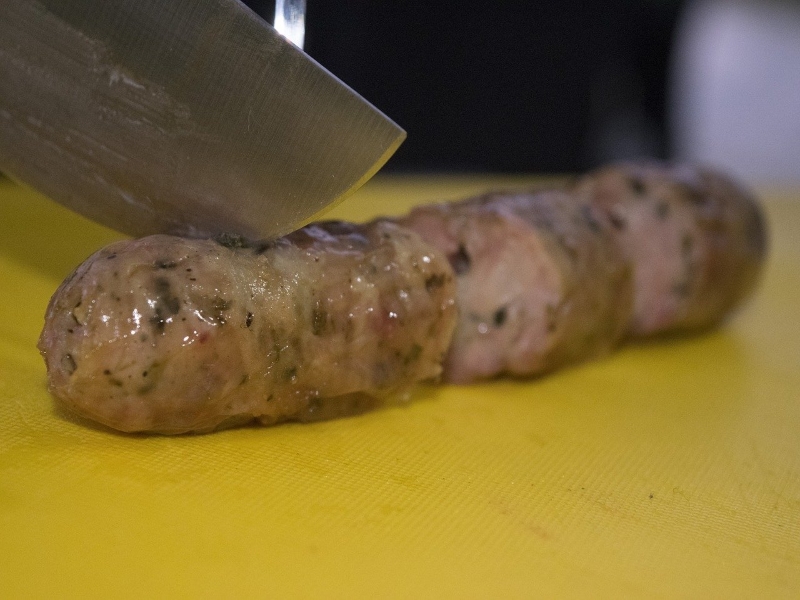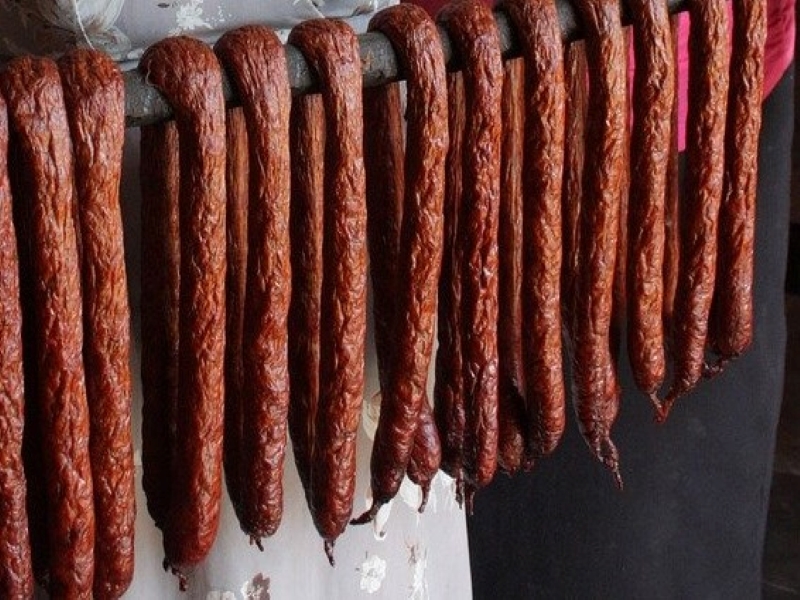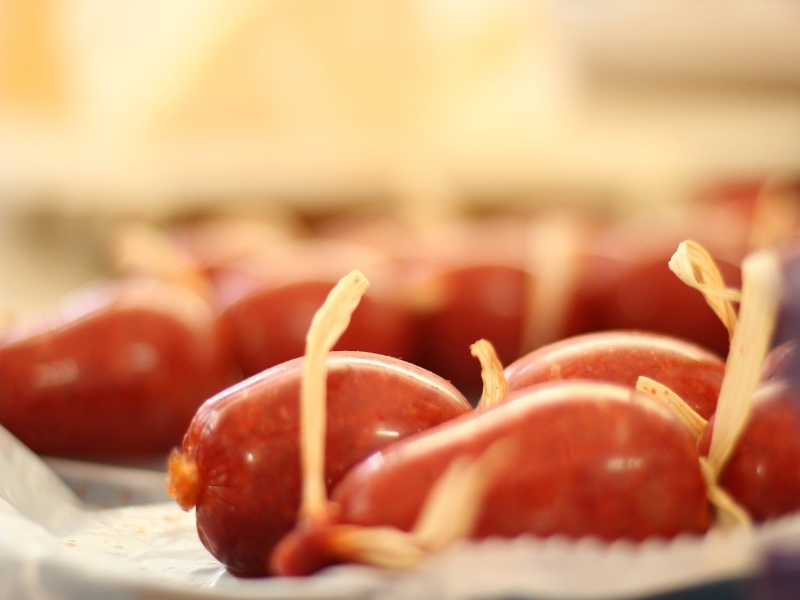Are you craving for Spanish sausages? In this article, we will talk about the popular Longaniza and Chorizo. Longaniza and chorizo are two different types of sausages that originated in Spain. These Spanish sausages look and taste so similar, it is easy to mistake them for one another, and it sometimes appears that they can be used interchangeably. They are both made of the same meat, which is pork. Some longanizas can be made of beef or other meats, while chorizo is generally made of pork meat. Despite their similarities, these two sausages are quite different dishes. So what is the main difference between longaniza and chorizo?
We have created this article to help you learn more about the difference between longaniza and chorizo. Check out the details of these two meats below.
Longaniza vs Chorizo

What Is A Longaniza?
Longaniza is a type of Spanish sausage, made of finely minced meat and spiced with black pepper. It is rarely cured, and is preferably used as raw meat for cooking . The ideal method is to use it as minced meat.
Argentina, Uruguay, Puerto Rico, Dominican Republic, El Salvador, Mexico and Chile all have their own versions of Longaniza.
Longaniza is made in a various ways, and varies depending on the country and region where it is made, but it is flavored differently from chorizo. Depending on the place, longaniza can be mild or spicy.
Longaniza Varieties
Spain
Longaniza is a type of salchichón (a sausage that is made by drying, smoking, cooking) in Spain that differs from chorizo, in that it uses black pepper instead of paprika and may contain other spices such as nutmeg.
Argentina and Uruguay
Longaniza in from Argentina and Uruguay is long, and cured and dried pork sausage from has a distinct flavor because of ground anise seeds. As a result, the stuffing has a distinct scent and a mildly sweet flavor that contrasts with the saltiness of the meat. It is mostly eaten raw or in sandwiches as an appetizer, and it is rarely cooked.
Mexico
Longaniza in Mexican cuisines is a long sausage. The meat is spicier and longer than their Mexican chorizo. Longanisa con huevo is a favorite breakfast dish made by chopped longaniza, and combined with eggs, tomatoes, or chile. It is usually paired with tortillas.
Chile and Peru
Longaniza can be eaten like a choripán (sandwich with chorizo) with bread on a barbeque in Chile and Peru. Longanizas are a specialty of the city of Chillán.
Dominican Republic
Longaniza in the Dominican Republic is made with bitter orange or lime juice, oregano, salt and garlic. Pork intestines are used to make the casing. The longaniza is then left to cure for a few days in the sun. It is fried in vegetable oil or in its own fats. Because it is usually cooked at home, the quality varies greatly. Longaniza of the highest quality usually has a lean fat level of 70%.
Philippines
Also spelled as longganisa in the Philippines. These are flavored sausages with various spices and achuete seeds. They are usually colored red, yellow, or orange.
Longganisas in the Philippines, are sausages produced with a variety of lean meat and fat, as well as garlic, black pepper, sea salt, saltpeter, muscovado or brown sugar, and vinegar. They are usually smoked or fresh.
Appearance And Flavor
Longaniza is dark red in color, and has a bolder flavor than chorizo. Compared to other types of cured meat, mild-flavored longaniza contains savory and robust flavors that make it unique. This Spanish sausage is commonly used as raw meat, and usually comes in long sausages. They are longer than chorizo sausage.
The spicy flavor of longaniza can be moderate or very hot. To make a spicier sausage, more spices and unique ingredients are added to the longaniza. In the United States, longaniza is spicier than chorizo.
Uses Of Longaniza
There are a various uses when cooking with longaniza. You can add them to your favorite meal or snacks, such as spicy tacos, breakfast wraps, charro beans, and can be mixed with your fried rice, fried egg or scrambled eggs. You can also add them to several soups, and stews. It can also be pan fried and served with steamed rice.

How To Make Homemade Longaniza?
Ingredients
- 1kg minced pork with 30% fat
- 2 tbsp vinegar
- 3 tbsp soy sauce
- 2 tsp annatto powder
- 1 1/2 tbsp salt
- 1 whole garlic (minced)
- 1/4 cup brown sugar
- 1 tsp ground black pepper
Preparation
- Combine the soy sauce, vinegar, and annatto powder in a big mixing bowl.
- Mix in all of the remaining ingredients. Mix everything together until the brown sugar has completely dissolved.
- Then, add the minced pork to the bowl, and mix well.
- Next, store the meat on the fridge for at least 2 hours or overnight. This allows the meat to firm and the flavors to blend thoroughly before shaping the sausages.
- To create a sausage form, place 2 tbspn of the meat into a wax paper then roll. If you don’t have one, you can form the sausages by hand.
- Remove the wax paper carefully, then pan fry the sausages using a small amount of oil in medium heat. You can use olive oil.

What Is A Chorizo?
Chorizo is a type of pork sausage that was originated in Spain and Portugal. It is finely ground and seasoned. Made out of short lengths of meat and placed into casings. It is frequently consumed outside of Spain and Spanish-speaking countries.
Chorizo is made from a combination of pork fat combined with chopped pork meat.
Red peppers, Spanish smoked paprika, salt, garlic and other seasonings are some of the most frequent seasonings for chorizo. Typically, chorizo is used as ground meat.
Chorizo is usually called Cajun sausage, and it is quite popular in the Cajun places of the United States, particularly in Louisiana.
Chorizo Varieties
Spain
Spanish chorizo is made from roughly diced pork and pork fat, seasoned with smoked paprika, garlic, and salt. It is usually categorized as a either spicy sausage or sweet sausage. It is typically a dried sausage.
Several varieties of both smoked and unsmoked Spanish chorizo may contain herbs and other ingredients.
Portugal
The Portuguese versions are usually spicier than the Spanish chorizo. Portuguese chouriço is their version of the Spanish chorizo. It is actually a different type of sausage, not to be confused with chorizo. Pork, fat, paprika, garlic, and salt are all used to make this sausage. Some regions also use wine and hot pepper as common ingredients.
Mexico
The Mexican variations of chorizo are produced not just from fatty pork, but also from beef, chicken, turkey, venison, and even tofu, kosher, and vegan forms. Mexican chorizo is based on the uncooked Spanish chorizo fresco (fresh chorizo). Different seasonings are used, and ground meat is also used instead of chopped meat.
Mexican chorizo is typically cooked with the same Capsicum annuum variety of native chili peppers, making it spicier than Spanish chorizo and Portuguese chorizo.
United States
Compared to Spanish chorizo, chorizo in the United States refers to a sausage that is never dried, the filling is fattier, and is spicier than other sausages. It is well known in regions with large Cuban, Dominican, or Puerto Rican populations, as well as areas along the Mexican border, such as Chihuahua, Sonora, and Nuevo Leon.
South America
Chorizo is the term for any coarse meat sausage in Argentina, Bolivia, Colombia, Peru, Uruguay, and Venezuela. A choripan is a famous bread roll in these regions. It filled with fresh chorizo that has been cooked and served. The majority of Argentine chorizos are made of pork and are not that spicy. Other meats, such as beef, are used in certain Argentine chorizos.
Bolivian chorizos are fried and paired with salad made of tomato, lettuce, onion, boiled carrots, and quirquia, mote and sliced bread soaked with chorizo fat.
Appearance and Flavor
Chorizo comes in a various lengths, it can be short or long. It is also available in hard or soft varieties. The leaner types are best eaten at room temperature as an appetizer or tapas, while the fattier versions are more commonly used in cooking.
Although this is not always the case, it is a general rule that thin chorizos are sweet and short chorizos are spicy.
Chorizo has a chewier, thicker texture than longaniza due to the method of packing and grinding.
Uses of Chorizo
Chorizo can be used for various dishes. Some people love to to add chorizo to their meatloaf or meatballs. It can also be added to soups, mixed with eggs, perfect in making Spanish rice with chorizo, stuffed chicken, Burritos and tacos, or chicken chorizo chili.

How To Make Homemade Chorizo?
Ingredients
- 5 pounds ground pork
- 2 tablespoons smoked paprika
- 4 cloves garlic
- 4 tablespoons kosher salt
- 4 tablespoons ancho chili powder
- 1/4 cup red wine vinegar
- 1/2 teaspoon white pepper
- 1/2 cup crushed red pepper flakes
- 3 teaspoons dried oregano
- 2 ounces hog sausage casing (about 14 feet)
- vegetable oil
Preparation
- The casing should be soaked in cold water for about 30 minutes. Check for leaks by running water through it.
- Using a blender, mix smoked paprika, garlic, oregano, vinegar, red pepper flakes, ancho chili powder, white pepper, kosher salt. Blend until smooth.
- Then, pour the mixture over the ground pork in a mixing dish. Using your hands, mix everything.
- Next, thread the casing.
- Slide the entire casing onto the tube, leaving enough at the end to tie into a tight knot, then remove the die from the grinder and attach the sausage-stuffing tube.
- Then, stuff the casing.
- Gradually feed the sausage mixture into the tube with the mixer on low, using one hand to guide the casing out at the proper speed, be cautious not to overstuff or tear the casing.
- Form the links.
- After you get about 3 to 4 feet of sausage turn off the mixer. Cut and tie off the casing. Continue making the remaining sausage by tying the casing to the stuffing tube. To make sausage links, pinch and twist the long pieces of sausage. Put the linked sausages on a wax paper with and put in the fridge overnight to dry.
Is It Important To Cook Both Longaniza And Chorizo?
You must cook longaniza and chorizo if you are not buying them pre-cured. Cured meat will resemble pepperoni and can be used in such a way.
Conclusion: Longaniza vs Chorizo
With that said, both longaniza and chorizo are quite similar and they can be used in various dishes and snacks. The main difference of these two sausages is that longaniza is often seasoned with black pepper and made from minced meat, while chorizo is generally spiced with paprika and produced from ground pork. Thank you for reading this post.

